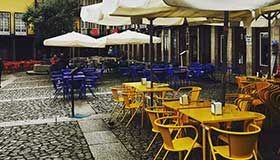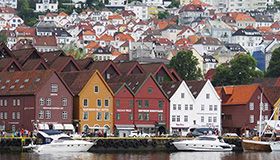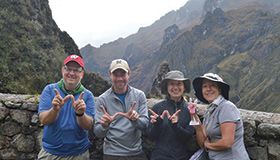On March 6, my husband and I embarked on an experience of a lifetime: hosting 30 WAA travelers for seven days and seven nights in Cuba.
We arrived at Havana Jose Marti International Airport after a short 45 minutes in the air on our American charter flight from Miami. After gathering our luggage, we were warmly greeted by our AHI tour host, Natalia; our Cuban educational guide, Jorge; and our bus driver, Jesus: a dream team for sure. Now in their capable and knowledgeable hands, we relaxed while enjoying the drive and soaking up our first glimpses of Havana and Cuban life. At lunch, we were greeted with the ever-present “welcome drink” and authentic tastes of Cuba.
Fully refreshed and energized, we proceeded to Revolution Square for a walking tour that took us all the way to the lovely Hotel Telégrafo, where Natalia had already checked us all in. At dinner, we experienced our first paladar: a type of privately owned restaurant whose establishment was allowed during a period of reform in the 1990s. These paladars became favorites of our group because they offer unique settings and menus not found in the state-owned establishments. This one, La Moraleja, did not disappoint: we were all treated to a 12-year aged rum and Cuban cigars after our meal.
On Tuesday, we explored Havana Vieja — the city’s historic district — and took in the sights of Plaza de Armas, the city’s oldest square. Through the architecture we learned of the many cultural influences that have shaped the people and places of Havana. We also visited the Museo de la Revolución to see extensive exhibits of Cuba’s history. Prior to lunch we learned more about Cuban architecture with Cuban architect Miguel Coyula as he discussed contemporary city planning in the Cuban capital. Like many of our meals, lunch was served al fresco. We enjoyed the ocean breezes with our Chilean wine and Cuban beer on the patio of El Templete and even watched a cruise ship docking in the harbor — a more frequent sighting in Cuba, with certainly more to follow.
In the afternoon, we were privileged to visit Finca Vigia, the home of the late author Ernest Hemingway. In this spectacular setting we saw the typewriter that he used to create some of his most famous novels later in life. In the evening, salsa lessons were offered, and most of the travelers gave it a try, although some were much better students than others! We were now ready to enjoy yet another spectacular meal at La Moneda Cubana, a nightcap at the Hotel Telégrafo bar for some, and a good night’s sleep.
Wednesday was classic convertible day! These beauties — all 1950s classics — were imported before the U.S. trade embargo began in 1960 and still run because of the ingenuity of their owners. The group enjoyed a drive through Havana’s historic quarter and past many of the historic landmarks, which Jorge pointed out. The group then hopped back on the bus for a few more stops, including the Sephardic Hebrew Center to learn about the history of Judaism in Cuba, plus the Malpaso Contemporary Dance Studio, where we were treated to a full hour of rehearsal by this amazing and wildly talented group.
La Barraca, at the seaside landmark Hotel Nacional, was our stop for lunch. After lunch, we were able to leisurely stroll the lovely grounds and tour bunkers that had been used to spot incoming sea vessels during more tumultuous times. We then visited the University of Havana to learn more about the educational system in Cuba and spotted more than a few hints that President Obama might be visiting there — many people were busy tidying up the buildings and grounds. Our final destination for the afternoon was the studio of the Havana Compas Dance Company, which has performed around the world and is scheduled to perform in Tampa later this year.
After a bit of free time, Professor Jorge Mario Sanchez led a discussion of the Cuban economy and how things might change following President Obama’s historic visit. Dinner and more amazing music followed at La Terraza, another Havana paladar.
Thursday we traveled to one of Havana’s oldest and most famous cigar factories and had the opportunity to purchase cigars and rum to take home. We were then treated to a personal tour of the national Museum of Fine Arts before enjoying another wonderful al fresco lunch at a local paladar. One of the most surprising highlights was the trip that afternoon to La Quinta Santovenia: a home for seniors where we met residents and were delighted to happen upon a medieval classical string quartet practicing in the chapel. The acoustics are so good that the group prefers practicing there than anywhere else!
To top off a wonderful, cultural day spent immersed in art and music, we enjoyed performances by the young students of Casa de la Cultura and dined under the stars at the paladar L’Atelier. It’s owned by a woman who had recently been recognized by the White House for her entrepreneurism in Latin America. Rumors were circulating that President Obama would stop there for dinner as well during his upcoming, three-day stay in Havana.
Exploring rural Cuba was the focus of our Friday trip to Las Terrazas, a model socialist community established in the 1980s. We visited the school, art studios, and organic vegetable gardens, and we enjoyed a lunch of creative cuisine prepared with local vegetables at El Romero. On the way back to Havana, we made a quick stop at Casa Fuster, where we toured artist Jose Fuster’s home and visited his art studio.
Saturday we waved goodbye to Havana and headed off to Cienfuegos, a UNESCO World Heritage Site. While en route, we visited a former sugar cane factory and enjoyed lunch at the Caribbean seaside restaurant Caleta Buena. A walking tour of Cienfuegos and dinner across the street from our hotel — again with live Cuban music — wrapped up the day.
With one more destination left, our happy group departed for Trinidad on Sunday to explore the architecture and enjoy the Cuban culture. Known for its French heritage and influence, the cobblestoned streets and quaint shops reminded us of New Orleans and felt somewhat familiar. We had a leisurely lunch and the opportunity to buy gifts and souvenirs while taking in the sights. Hot and just a little tired, we boarded our bus to head back to Cienfuegos for our last evening in Cuba. That night, we sadly bid farewell to Jorge because he was joining another group the next day, and we presented him, Natalia, and Jesus with UW alumni pins, dubbing them “honorary alumni” for their extraordinary services.
Cuba certainly did not disappoint, and the neither did our wonderful, curious, easygoing, and open-minded group of 30 travelers. Until next time!







